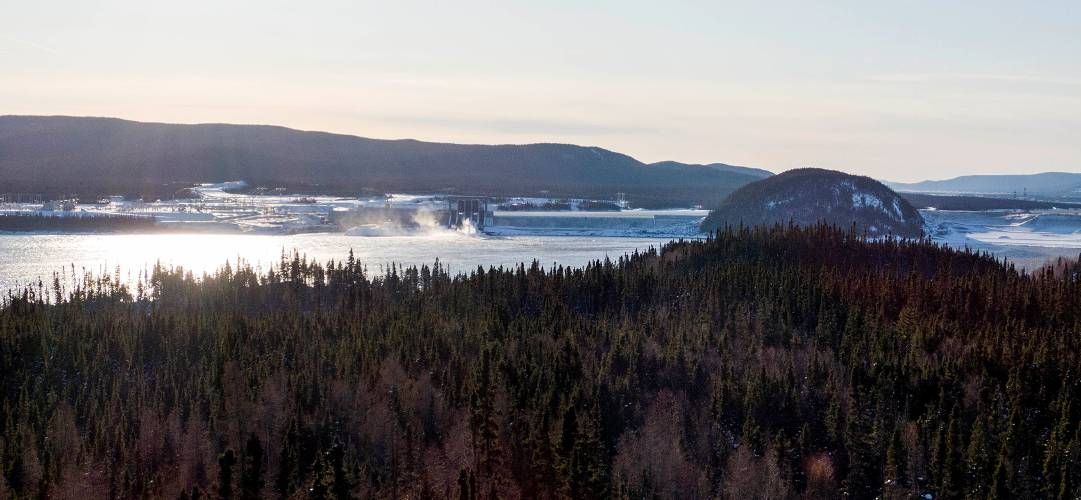HAPPY VALLEY-GOOSE BAY, Newfoundland — Amid the last 20 years of worsening impacts from climate change, environmentalists in Vermont and New Hampshire have scrambled to nudge state leadership toward ambitious renewable energy goals.
And a key component of meeting those goals has been Canadian hydropower, a cost-effective, reliable resource that is often billed as clean, green energy.
The New England ISO, which regulates New England’s electricity infrastructure, currently gets 1.4 Terawatt hours of electricity from damming projects from the provinces of Quebec and Newfoundland and Labrador, some of which goes to New Hampshire. About a third of Vermont’s energy comes from Canadian hydro plants through the Highgate interconnection.
That’s enough to power about 400,000 New England homes. And even with the permitting failure of the proposed Northern Pass project — a 192-mile transmission line across New Hampshire that would have carried hydropower to southern New England — those numbers are expected only to increase.
But hundreds of miles to the north, indigenous residents say the “green” power purchased by New Englanders comes at a great cost to native communities’ local environment, livelihoods and their health.
“Think about what you’re buying here,” 78-year-old Alex Saunders said in his graveled voice last month, in his living room in Happy Valley-Goose Bay in Labrador. “You’re buying the misery from the local people of northern Canada. That’s not a good thing.”
Wearing dark-blue suspenders over a wrinkle-free dress shirt, Saunders sat in the living room of his neat, modern home; above his head, a wall-mounted harpoon spoke to his career as captain of a successful commercial fishing operation, while a soft divot on the surface of his balding head spoke to the dangers of growing up in a remote and rugged wilderness along the subarctic Labradorian coast.
The divot has been there since Saunders was 3, when he and his older brother were digging for mice outside their remote cabin in the woods. When an inadvertent swing of the mattock — a gardening tool shaped like a pick-axe — fractured his skull, his brother carried his bloody body inside; there, his mother poured kerosene over the wound, packed it with lichen and spiderwebs, and wrapped his head in a snug cap. Two days later, he regained consciousness.
By then — the 1940s — the forces of colonization had a long-established pattern of ripping apart First Nations communities in the region. His mother was orphaned at 6 when the Spanish flu decimated her Inuit village of Okak in 1918, and his father, of Innu and English descent, was orphaned at 7.
Thousands of children were separated from their families and forced to attend English-only residential schools, while Inuit and Innu were compelled to trade their independent, nomadic lifestyle for a wage-based economy and living in what Saunders calls “white people houses.”
To many Inuit, the damming projects along the Churchill River are just the latest — and in some ways the worst — expression of ongoing colonization of their people.
New England’s Energy Crisis
New England’s appetite for hydroelectricity has stimulated a juggernaut industry across the Northern border — 62% of the energy Canada produces is from hydropower, amounting to a $37 billion contribution to Canada’s GDP and 135,000 jobs, according to a 2015 report from the Canadian Hydropower Association.
The environmental impacts of that energy are tied up in more than 900 large dams on Canada’s waterways, with 14 of its largest 16 rivers dammed, according to International Rivers, a nonprofit advocacy group.
Saunders’ hometown of Happy Valley-Goose Bay (Labrador’s largest city with 8,000 residents), lies where the mighty Churchill River flows into Lake Melville, the catchment area for Labrador’s largest watershed. At the eastern end of the lake, the waters flow into the Labrador Sea near the unforgiving tundra terrain of the Inuit — here, polar bears nose into tents, temperatures regularly reach 20 below, and the slightest miscalculation during travel can send dogs, sled and driver through rotten ice and into deadly waters.
The relentless flow of the Churchill is what produces most of New England’s Canadian hydroelectricity. About 170 miles upstream from Lake Melville, a large hydroelectric project — the Churchill Falls Generating Station — was built in 1970 as a partnership between state-owned provincial corporations. Capable of producing 5,428 megawatts of electricity, the Churchill Falls project is, even today, the second-largest hydro plant in Canada, and 10th largest in the world.
Nalcor, a partner in the Churchill Falls project, is nearing completion on another hydroelectricity project on the same river, the 824-megawatt Muskrat Falls.
Located just 25 miles upriver of Happy Valley-Goose Bay, Muskrat Falls features a new dam, which flooded 16 square miles of traditional Innu hunting grounds earlier this year. The Innu, who had a governmentally recognized claim to the land, approved the project in exchange for terms including a cash payment of about $2 million a year, but Saunders said the land was also heavily used by other groups, including the Inuit and the Nunavut. “Everyone had a connection to that area. Everyone knew it was a special place,” Saunders said. “That’s where the old trappers would walk up over the land, portage with the big canoes and 500-pound packs, they’d walk over the [expletive] mountain. That area was very well-used and revered by the people.”
Saunders, an Inuit elder, has devoted much of his time in recent years to passing on his cultural knowledge to a younger generation, in part by writing books about his life experiences. Like most people in his community, he is opposed to the dams on many grounds, but is most bothered by their effect on the local food supply.
Country Food
The area around the Churchill and Lake Melville is full of First Nations people who have a deep connection to the land; that connection is nurtured through the procurement, and eating, of “country food.”
“Number one, I really like seal meat. And seal fat,” Saunders said. “Caribou is second. We ate ducks, geese, ptarmigan and the spruce (grouse). A lot of fish.”
In his boyhood cabin in the woods, his mother made shiva — cod liver, fried to extract some of the grease, and then made into a pate.
“We would have a barrel of shiva in our porch and we would have a barrel of blackberries,” he said. “Normally the berries would be froze, but the liver wouldn’t freeze because of the oil.”
He would take a handful of each, and mix them together — “like an ice cream treat.”
As a young adult, Saunders spent extended periods of winter fishing in Goose Bay with a friend.
Many First Nations residents say that, after centuries of being forced to assimilate into Western culture, the hydroelectricity projects are now driving a wedge between themselves and their most important connection to the land — their food.
Saunders has no doubt that the increased methylmercury levels found in fish downstream of the Churchill Falls project contributed to his own diagnosis of “very high” levels of methylmercury.
“It must have, right? Where else would I get it from?” he said. “Primarily, I lived on food from this area.”
Saunders, who still gathers herbs to treat a variety of ills, decided to treat his mercury poisoning with an alternative medicine. In chelation therapy, a synthetic chemical called ethylene diamine tetraacetic acid is administered through an IV. The chemical attracts heavy metals from the bloodstream before exiting. Because it carries the risk of severe side effects, chelation is controversial in both the U.S. and Canada, but Saunders said it worked for him.
“I certainly did that a lot in my drinking days,” he said. “We’d be here in town drunk for a week, or maybe 10 days. Get out of money and be just in the wrecks. Shaking, throwing up. So we’d get the (expletive) out of town, is what we’d do.”
They would walk for miles, and pitch a lakeside tent to sleep in. Every morning, they went to their fishing hole where, dressed in denim jeans and long underwear against subzero temperatures, they built a windbreak from blocks of snow.
“We’d sit by the hole for hours,” he recalled. “We’d fill these gunny sacks, fill them right up with smelt. Stay there until we had maybe eight or 10 of them full of three or 4,000 smelts. Then we’d come back to town. Then we’d sell them for 2 cents a smelt. Then we’d get drunk for another week. Then we’d go back out on the land again and do it all again.”
Though Saunders, who gave up drinking 40 years ago, still prefers country food, it is no longer a practical necessity for him. He made his fortune as a commercial fisherman — as captain of a small crew, he’s chased stocks of cod, crab, scallops and much more throughout northern waters that stretch from Newfoundland, to Greenland, to Scotland.
But as he worked, he began to notice a problem, first in the bitterest cold, and then in increasingly warm temperatures: His fingertips would get white and numb. And after the numbness, Saunders would be struck with “pain like the devil.”
On the advice of a doctor, Saunders sent a bit of his hair to be tested in a lab in Chicago. He soon learned that he was suffering from methylmercury poisoning.
Mercury is a naturally occurring substance, but once it enters lakes and rivers, it is absorbed by aquatic bacteria and transformed into methylmercury, which can damage the neurological system of humans.
Hydro-Quebec acknowledges the presence of the substance in some of its properties.
“In recently impounded hydroelectric reservoirs, the green parts of the terrestrial vegetation (i.e., the ground cover, leaves and moss) provide food for the bacteria that convert the inorganic mercury to methylmercury,” the company says on its website.
Researchers from Harvard University have found that Lake Melville’s patterns of water stratification, which are driven in part by its mix of fresh and salt water, may also concentrate the methylmercury, and magnify its effects.
As the toxic metal passes through the food chain, it accumulates in cod livers and smelt, as well as in the fatty tissues of other fish, seals and birds.
After concerns about methylmercury poisoning were first raised, both Nalcor and the Nunatsiavut Government tested local Inuit populations living downstream of the Churchill Falls dam, and both concluded that they have elevated levels of mercury in their systems. The more an Inuk relies on country food, the higher his or her levels of contamination.
Nalcor and the Nunatsiavut Government, which represents the Inuit, disagree on the extent to which the dams affect mercury levels. Nalcor has implemented a monitoring program to track mercury in the environment and work with government agencies to, if necessary, modify public health recommendations for certain types of fish consumption.
The Nunatsiavut Government says the testing is not comprehensive enough. It also failed in a bid to compel Nalcor to spend a considerable sum to remove mercury-laden vegetation and cap wetlands before flooding Muskrat Falls in late August.
Continued Marginalization
Describing a dynamic that would be familiar to any rural resident who feels caught in the political gravity of urban population centers, Saunders says Labrador is marginalized within the province of Newfoundland and Labrador. Labrador has 70% of the province’s natural resources, but only about 6% of its population, which Saunders said results in Labrador’s needs being habitually overshadowed in the provincial House of Assembly.
Many in Happy Valley-Goose Bay see the marginalization of the Inuit in the state-backed Muskrat Falls project as just the latest example in an ongoing campaign of cultural genocide.
“I think it’s wicked,” said Jan Morrison, whose husband, a lifelong resident, introduced her to the Muskrat Falls area.
Morrison said eco-conscious New Englanders should be as thoughtful about their power as they are about their food.
“Do you think it’s OK to get green beans from China? Or do you think that is possibly a bad idea, for many reasons? Like, wake up. Just because it’s your power doesn’t mean you shouldn’t examine where it came from.”
Roberta Benefiel, a director with Grand Riverkeeper Labrador, has traveled to the Twin States, and throughout New England, several times to raise awareness of the environmental impacts of what the group calls “MegaDams.”
“It’s not just about methylmercury,” Benefiel said. “It’s about the natural flow of the river, and the loss of a valuable natural resource.”
Though Saunders is opposed to the dam, he’s done fighting it.
“I’m not going to make it the focal point of my life,” he said, “I won’t support it. And I don’t like it. But you’ve got to roll with the punches. I’m 78, going to be 79 years old. I’ve learned through my life’s journey that you’ve got to accept what comes your way. And you have to try to accommodate anything that’s happening and you have to adjust to it.”
Saunders has tried to shield his children from the worst impacts of colonization. A successful career on the seas has allowed him to provide significant support to his daughter Erin, now 35. Throughout her life, he taught her many traditional skills — to hunt seals in springtime, to collect eider eggs in summertime, to fish for smelt in the wintertime — but she never learned his grudging acceptance of the loss of Inuit culture.
And the generational impacts of colonization never seemed more impactful, or more literal, to Erin Saunders than when she, and various other Inuits opposed to the Muskrat Falls project, were thrown behind bars.








